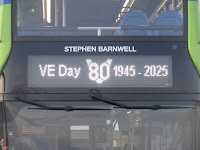With all 28 arches, more or less, dismantled, the Madeira Terraces restoration project (phase 1) remains on schedule to finish sometime in the middle of next year. However, Mike, a representative of the construction company J T Mackley & Co, speaking to a small public meeting in the Sea Lanes Club House this afternoon, insisted this timescale was only a target, and that if any of the integral pieces, once dismantled, are found to need replacing - as opposed to strengthening or repairing - this could delay the project significantly.
This project has been a long time in the coming (see Madeira Terrace restoration - hurrah!) but now that it is under way, progress is visible and tangible. It’s almost shocking to see the concrete sea wall - actually built decades before the cast iron terraces were ever planned - with all the turquoise painted cast iron terracing removed. Mike explained that everything has gone reasonably well so far, some aspects easier than expected, others more complex. The final arch (of the 28 being restored in this phase) he said, should be down next week. He also gave some insights into the complex restoration process.Every piece is being tagged, he said according to a system agreed with English Heritage, before cleaning and stress testing etc. - to ensure the pieces fit back together in the right position. The company does have access to plans drawn for the original construction (in late Victorian times!), but Mike said rather wryly, those plans were never adjusted according to what the builders actually built - making them an unreliable guide.
To date, the major pieces cleaned and tested have proved robust enough to re-use; however, Mike warned, if any, still to be tested, show defects that cannot be repaired, then they will need to be replaced. This is a job that would be carried out by one of Mackley’s partner in this project, a foundry works in Derby (very few places could handle this work, Mike explained) - and could delay completion by months. Among other aspects of the project, Mike talked a little about the rebuilding of the Maderia Lift which, he said was in the design stage and was ‘going quite well’.









.jpeg)







